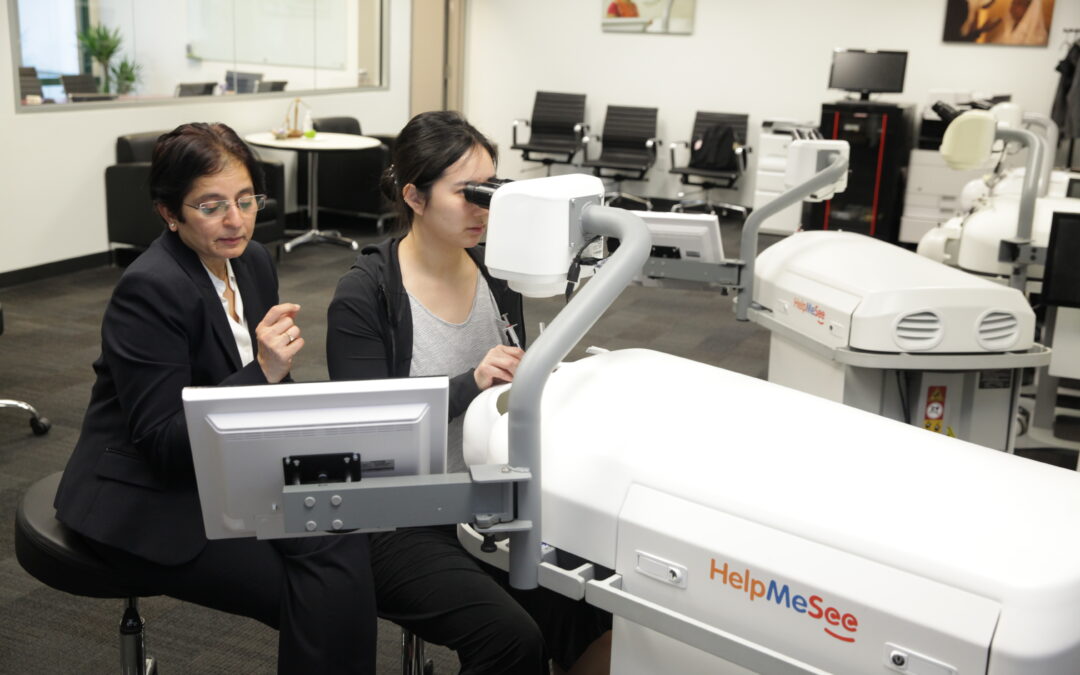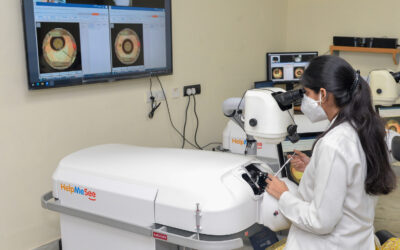Discovering the science behind virtual reality in eye surgery training with the HelpMeSee Eye Surgery Simulator.
Cataract surgery is one of the safest and most effective ocular procedures. Like any surgical intervention, however, it is not without risk. Although most complications do not cause long-term visual impairment (1) and can be managed during the procedure effectively, proper training is key to employing successful surgical strategies.
In most residency training programs, the primary focus is preparing trainees for routine cataract surgery. Complication rates during surgery are typically 3.8% to 10.2% higher for trainees compared to practicing ophthalmologists. (2,3) Trainees who use virtual reality–based cataract surgery simulation to practice surgical techniques, however, are more likely to develop greater surgical skill efficiency and confidence compared to those who train in wet labs. (4) Surgical skills development is especially crucial in the post–COVID-19 era. Research indicates that the number of surgeries performed or assisted by trainees in the United States declined significantly in 2020 and 2021 from previous years, as influenced by the pandemic. (5)

“There is a significant mismatch between the number of surgeries needed to be performed to master them and the actual numbers being performed by trainees,” wrote Vongsachang and colleagues in a paper highlighting the impact of COVID-19 on ophthalmology resident surgical experience. (5)
For many years, eye surgery training on animal eyes and with vegetative material and inanimate objects has been used as a way for residents to practice surgical techniques. More recently, virtual reality–based surgical simulation has emerged as a powerful adjunct to more traditional instruction, offering numerous benefits and leveraging scientific principles to enhance learning and performance. This type of simulation training provides a controlled surgical environment that is visually realistic and offers motorsensory feedback, mimicking real-life surgery. Residents can practice crucial skills and perform various surgical steps to gain practical experience, refine their technique, and develop aptitude and confidence that can translate to the OR. Additionally, virtual reality–based surgical simulation allows residents to practice various logics for complex cases and complications management, offering invaluable preparation for real-life surgery. They can even intentionally and repeatedly make mistakes to learn how to manage and even avoid surgical complications.

Studies have shown that surgical simulation training can significantly reduce the rate of complications for novice residents. (6) Additionally, a randomized, controlled trial showed that trainees made fewer errors in their first 20 independent surgeries when a virtual reality–based simulation system was used compared to traditional training methods. (7)
Simulations with active feedback mechanisms, like the HelpMeSee Eye Surgery Simulator, enable residents to receive immediate evaluation and guidance for improvement, promoting active learning and knowledge retention. By repeatedly performing tasks and conquering various surgical scenarios, individuals can strengthen the neural pathways associated with specific skills, leading to improved proficiency over time. (8) Simulation can also enhance memory encoding and retrieval, optimizing learning outcomes. (9)

The HelpMeSee Eye Surgery Simulator is designed to support cataract surgery training through virtual reality–based simulations. The inclusion of instructors in this learning model ensures users receive external verbal feedback that results in lasting improvements in performance. (10) They first demonstrate the steps and then observe and give trainees immediate feedback on their surgical technique, instrument positioning, and advice on how to improve. At the end of the training, instructors assess the trainee’s surgical competency with the HelpMeSee Eye Surgery Simulator software, which compares surgical performance with objective parameters and competency assessment rubrics. (10) The simulator is also used to assess the user’s performance of specific maneuvers, such as the size of the capsulorhexis and depth of the incision tunnel, as well as the number of errors made and zonular damage caused. (11) Trainees can also view video recordings of their simulation procedures, offering an opportunity for reflective learning.
The HelpMeSee Simulation-based Training courses include Manual Small-Incision Cataract Surgery, Phacoemulsification, Suturing, and Complications Management. The virtual reality simulation is one component of the HelpMeSee training program, which also consists of self study, classroom sessions, and hands-on laboratory exercises.
Virtual reality–based surgical simulation training is a win-win for residents and residency program directors. It can be used to teach vital surgical skills, better prepare residents for managing complications, and ultimately improve patient safety.
Learn More About Training in Your Region
Instructor-led Simulation-based Training Courses
Learn More About Training in Your Region
Instructor-led Simulation-based Training Courses
Learn More About Training in Your Region
Instructor-led Simulation-based Training Courses
HELPMESEE SPONSOR’S






- Stein JD, Grossman DS, Mundy KM, Sugar A, Sloan FA. Severe adverse events after cataract surgery among Medicare beneficiaries. Ophthalmology. 2011;118(9):1716-1723.
- Rogers G, Oetting T, Lee A, et al. Impact of a structured surgical curriculum on ophthalmic resident cataract surgery complication rates. J Cataract Refract Surg. 2009;35:1956-1960.
- Hashemi H, Mohammadpour M, Jabbarvand M, Nezamdoost Z, Ghadimi H. Incidence of and risk factors for vitreous loss in resident-performed phacoemulsification surgery. J Cataract Refract Surg. 2013;39:1377‐1382.
- Thomsen AS, Bach-Holm D, Kjaerbo H, et al. Learning cataract surgery: wet-lab versus virtual reality training. Acta Ophthalmol. 2014;92(7):629-633.
- Vongsachang H, Fliotsos MJ, Lorch AC, Singman EL, Woreta FA, Justin GA. The impact of COVID-19 on ophthalmology resident surgical experience: a retrospective cross-sectional analysis. BMC Med Educ. 2022;22:142.
- Staropoli PC, Gregori NZ, Junk AK, Galor A, Goldhardt R, Goldhagen BE. Surgical simulation training reduces intraoperative cataract surgery complications among residents. Simul Healthc. 2018;13:11-15.
- Nair AG, Ahiwalay C, Bacchav AE, et al. Effectiveness of simulation-based training for manual small incision cataract surgery among novice surgeons: a randomized controlled trial. Sci Rep. 2021;11:10945.
- Sayala S, Sala JB, Courtney SM. Increased neural efficiency with repeated performance of a working memory task is information-type dependent. Cerebral Cortex. 2006(16);5:609-617.
- Sato N, Yamaguchi Y. Simulation of human episodic memory by using a computational model of the hippocampus. Advances in Artificial Intelligence. 2010. doi: 10.1155/2010/392868
- Lansingh VC, Nair AG. More than simulation: the HelpMeSee approach to cataract surgical training. Community Eye Health Journal. 2023;36(120):4-5.
- Lansingh VC, Ravindran RD, Garg P, et al. Embracing technology in cataract surgical training – the way forward. Indian J Ophthalmol. 2022;70:4079-4081.
- Nair AG, Ahiwalay C, Bacchav AE, Sheth T, Lansingh VC. Assessment of a high-fidelity, virtual reality-based, manual small-incision cataract surgery simulator: A face and content validity study. Indian J Ophthalmol. 2022;70(11):4010-4015.
RECENT NEWS
The Impact of Simulation-based Education in Ophthalmic Residency
Residency is the cornerstone of surgical education. Designed to prepare medical students for the rigors of surgery, the intensive program typically...
The Role of MSICS Training: Building Skills for Phacoemulsification Success
Phacoemulsification is the predominant cataract surgery technique in the United States. In other parts of the world, especially in low-resource settings,...
The Community Ripple Effects of Cataract Surgery Training
Around the world, millions of individuals suffer from cataract blindness—a condition that is preventable and treatable. About 90% of those affected by...




